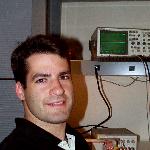Overview
Directional audio cues play an important role in our perception of sound. In this project, we are developing very simple sensors that determine the bearing of incoming sound waves, giving a computer easy access to directional audio information. The initial devices are broadband, passive monopulse acoustic receivers made from PVDF foil. By properly shaping the electrode patterns on the PVDF and mounting the foil appropriately, a simple ratio of two signals determines acoustic bearing over a wide frequency band without dispersive effects; the signal processing is effectively performed by the transducer's aperture shape. We are developing such devices that respond well into the audio band, thus providing directional cues for human speech. We are also exploring other audio applications of distributed-aperture transducers.Work To Date
Most of our work of this style of devices has centered around an audio direction-finding microphone. The theorectical basis for such a device, which exploits simple properties of derivative-matched aperatures, was laid by T.L. Henderson of UT-Austin. A hyrdrophone version of this device was developed and tested for underwater applications at Draper Laboratories several years back by Shawn Burke, Joseph Paradiso, and colleagues. We have completed a project at in the Responsive Environments group at the MIT Media Laboratory to construct an audio-frequency microphone based on these principles and operating in air.So far, two working prototypes have been created. Both have worked very well qualitatively, and we now in the process of fully characterizing the device. A video clip of our current prototype in action is available. These devices are technically quite simple and require very little signal processing to recover the desired bearing information for clean acoustic transients. The transducer itself is a piece of PVDF piezoelectric foil with two coincident aperatures on it. Because of the relationship between the shadings of the two aperatures, the incident direction is simply the ratio of their outputs. The system derives two very important properties from this design. Firstly, it is theorectically broadband. The use of the PVDF, which acts as a continuous pressure integrator, helps to maintain this frequency independence in practise. Secondly, it is non-dispersive because of the coincidence of the aperatures.
There are many potential uses for such a device, especially in the area of human computer interaction. Humans use directional cues from sound to glean its context (e.g. to whom the sound was directed) and therefore the relevance of its content. Computers lack this ability and tend to use rather complicated algorithms to determine the entire content of a message when knowledge of the direction of the sound alone would suffice. Other potential uses involve video conferencing systems where the camera would turn to face the speaker and simple, robust systems for sound source location (e.g. inner-city gunshot source determination).
Our current prototype was characterized
by Phillip Rowe in his thesis,
completed May 1999. Also included is a discussion and preliminary
testing on the possibility of using such a device with human voice input.
Future Directions
These devices offer two unique properties that we hope to exploit. The first is the ability to create audio systems with arbitrary response, since the aperature shading itself is effectively the impulse response of the system. The second is the potential to combine both spatial and temporal information in our processing, by merging the concept of a distributed aperature with that of a delay line. Very little work has been done in this field, and we hope to build some interesting devices to show the value of this type of design.
Further Information
A Video Clip (600K MPEG) of the Backgammon ratio signal responding in real time to an audio impulse. You can see the ratio value track the incident angle.
A short presentation on this system given at the Media Lab by Phil Rowe during his thesis research.
Phillip J. Rowe -- "Characterization of a Wideband Monopulse Piezoelectric Direction Finder," M.Eng. Thesis, MIT EECS Department and MIT Media Lab, June 1999.
"High-Resolution Piezopolymer Acoustic Bearing Estimator," Shawn E. Burke and Joseph A. Paradiso, Presented at the Second Technical Conference on Telecommunications R&D in Massachusetts, University of Massachusetts, Lowell MA, March 12, 1996.

Joe Paradiso


